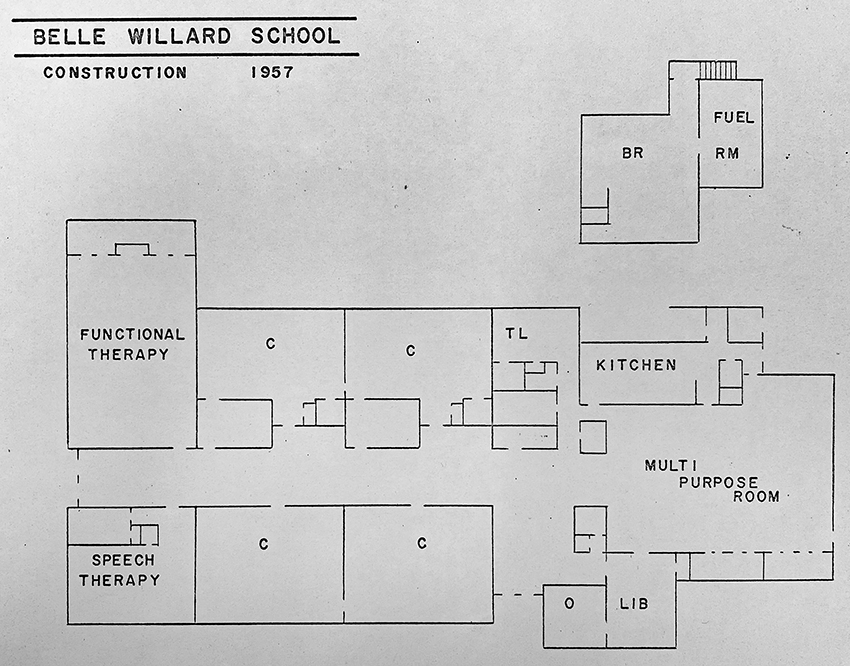School History: Belle Willard School
Remembering Our Past
Known variously in historic records as Belle Willard Elementary School, the Belle Willard School for Handicapped Children, or simply Belle Willard School, the small building pictured below was the first school constructed by Fairfax County Public Schools specifically for use as a special education center.
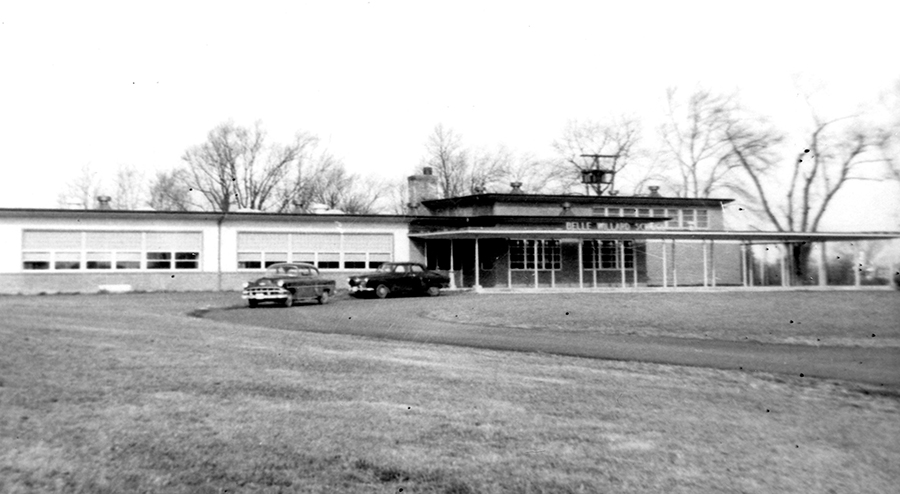
The building is contemplated to be built adjacent to the County Health Center [Joseph Willard Health Center], now under construction, on 1.5 acres of land donated by the heirs to the Willard Estate, so that these children can conveniently be offered the facilities of the Health Center for therapy of various types. Mr. Macomber explained in quite some detail how this building was planned for the convenience and best adjustment of the children attending, explaining the function of each room. It was particularly noted that handrails are to be placed in all areas, including classrooms, and that toilet areas are planned in a manner to best aid these children. ~ Fairfax County School Board, Meeting Minutes, May 27, 1954
Two years of planning and research went into the design of the Belle Willard School. The building’s layout, drafted by architect Walter Macomber, was approved by the State Board of Education in the spring of 1956.
[The blueprints] represent coordinated study by local and state educators and health officials to determine what facilities would best serve young victims of cerebral palsy or muscular dystrophy who have alert minds and are eager to learn. The school will cost about $150,000 and will house some 80 children with room for expansion. Before authorizing the blueprints, school administrators decided the primary purpose of the plant would be to educate the youngsters, with therapy as a second objective. ~ The Washington Post, March 11, 1956, Page B-6, School for Handicapped To Be Built by Fairfax.
A Small School
Belle Willard was a small school with just four classrooms, a functional therapy room, a room for speech therapy, and a multipurpose room with a portable stage which served as a cafeteria and meeting space. There was also a small dining alcove to provide privacy for children who had difficulty eating or could not feed themselves. The building also had wide hallways and ramps in place of steps to accommodate wheelchairs.
Building Belle Willard
In June 1956, the contract for the construction of Belle Willard School was awarded to W. A. Sherman, Inc., of McLean, Virginia. Built at a cost of $213,700, Belle Willard opened its doors to students for the first time on September 3, 1957. About 40 students were enrolled at Belle Willard during its first year. Vera K. Louden served as the school’s principal-teacher from its opening until 1960.
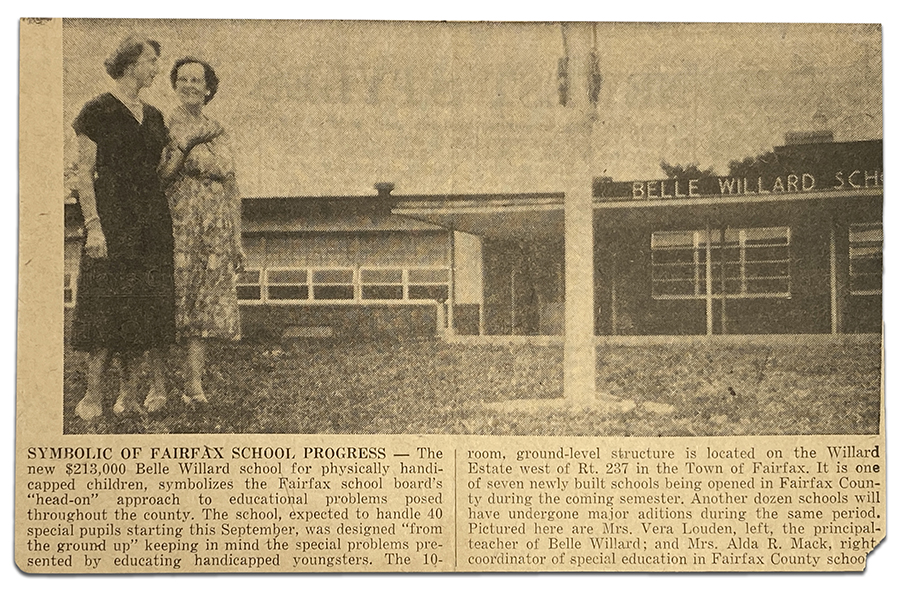
Fairfax County was commended yesterday for its leadership in providing facilities for physically handicapped school children. Belle Willard, now in its second year, is the only school of its kind in the state. It has 36 students, three teachers, an occupational therapist, and two attendants. ~ The Washington Post, February 11, 1959, Page B-4, Fairfax Lauded for Role in Aiding Handicapped.
Out and About
From 1960 to 1973, as the student population of Fairfax County increased by some 76,000 students, the number of students needing special education services increased from about 400 to approximately 650. In the 1960s, the administration of nearby John C. Wood Elementary School and the Belle Willard School was consolidated under a single principal, and an assistant principal was hired to oversee operations at Belle Willard.
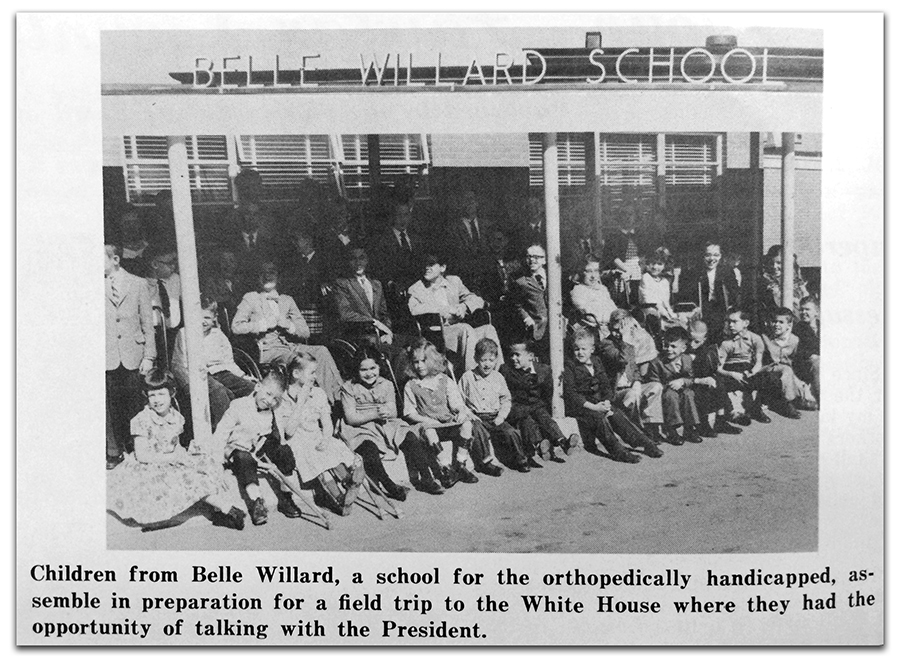
Belle Willard’s location adjacent to the Joseph Willard Health Center and John C. Wood Elementary School provided opportunities for Belle Willard’s students to receive specialized therapeutic care and engage in learning activities with general education students. Aurelia Howland, principal of Wood Elementary School, recalled in an interview that Wood’s 5th and 6th graders pushed the wheelchair-bound Belle Willard students between the school buildings on assembly days and while on field trips.
Closer to Home
From 1970 to 1972, enrollment at Belle Willard increased from 66 students to 86. At the same time, parents were becoming more and more vocal about their objections to having their children transported across the county to a facility that segregated children with special needs from general education students. The parent consensus was that physically handicapped children could best be taught in schools located near their homes.
Our physically handicapped children are required to ride buses up to four hours daily just to get two and from school. Many of these children make the long bus rides in wheelchairs, braces or a variety of other uncomfortable appliances. ~ Jerome Hoeschen, Belle Willard PTA, February 9, 1972
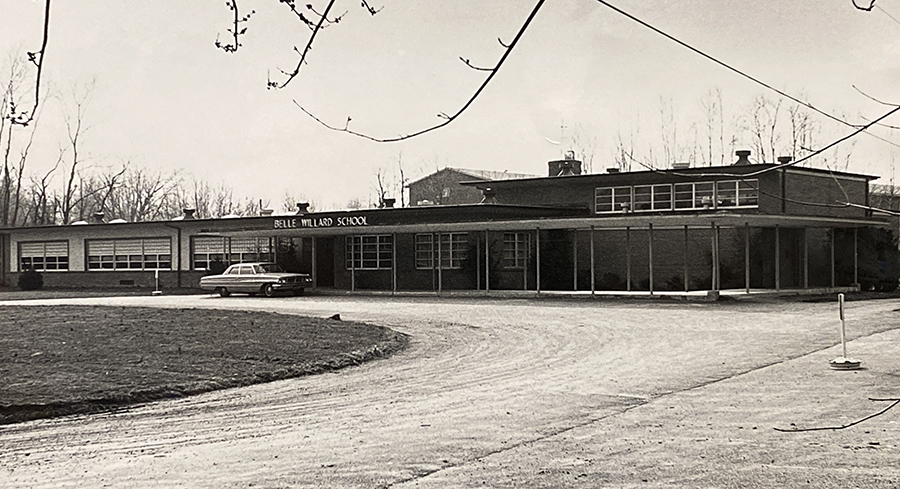
In 1972, Belle Willard was the only one of Fairfax County’s 168 public schools that had facilities designed to accommodate students with physical disabilities. Reynolds Thomas, president of the Fairfax County Federation of Citizens Associations, addressed the Fairfax County School Board in February 1972 and recommended that special education and other school buildings be combined to eliminate the segregation of children with special needs. One month later, in March 1972, the results of a broad study entitled “Blueprint for Action: The Special Education Study” were presented to the School Board.
[The study committee] said that integration of mentally and physically handicapped children into regular schools now has been shown to be educationally sound. Such integration also is being demanded more and more by parents who think their children are stigmatized in special facilities. The committee recommended that all kindergarten through sixth grade students now attending the Belle Willard School be transferred to regular elementary schools within the four administrative areas. This not only would allow the pupils to take part in regular school activities but reduce extraordinarily long bus rides for some. ~ The Evening Star, April 1, 1972, Page B-4, Special Classes Hit In Fairfax Report.
Shortly thereafter, FCPS began constructing small centers within existing schools as a way to relieve overcrowding at Belle Willard and to provide services to students with special needs closer to their homes. One such center, at Bush Hill Elementary School, was constructed beginning in the summer of 1972.
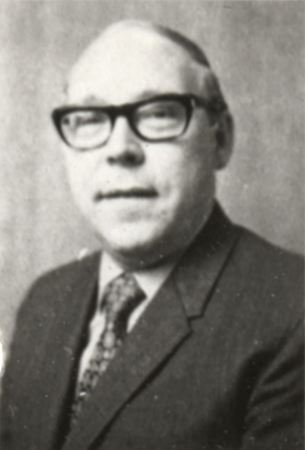
The Establishment of Fairhill Center
In 1975, the School Board decided to close Belle Willard School and approved the construction of a center for physically handicapped children at Fairhill Elementary School. During the fall of 1976 and the spring of 1977, regular meetings were held between Clifton V. Munn, then principal of Belle Willard, and Fairhill’s principal Richard Claybrook. Staff from Fairhill toured Belle Willard School, and likewise Belle Willard staff toured Fairhill, in an effort to ease the consolidation of the two school communities.
On May 25, 1977, Belle Willard Center closed, and the students transferred to the new center at Fairhill. The center included six new classrooms, a new gym, therapy facilities, a music room, adaptive bathrooms, and a hydrotherapy pool. Approximately 50 students and 15 to 20 staff members moved to Fairhill from Belle Willard, and Clifton Munn became the first principal of Fairhill Center.
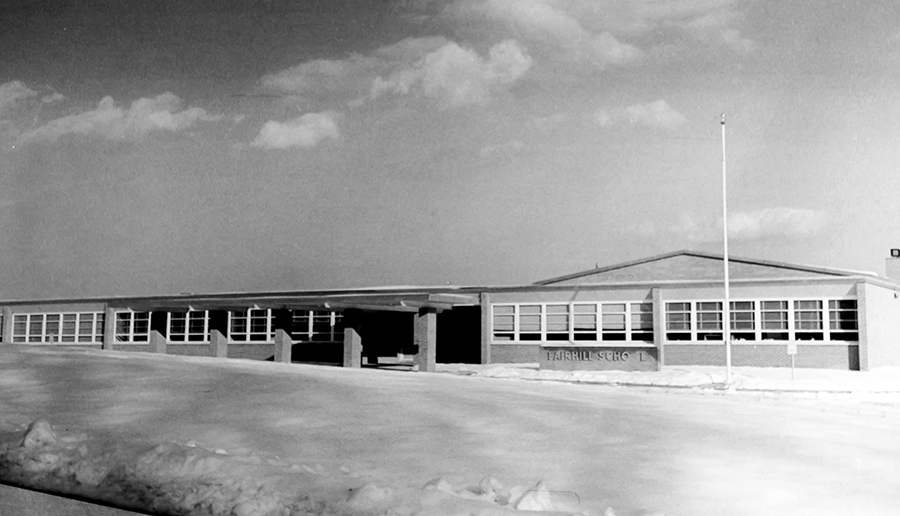
The merging of the two school communities into one, although ultimately successful, took time. In the beginning years of Fairhill Center, the center students continued many of their Belle Willard traditions, including wheelchair basketball games, the crowning of a king and queen for Valentine’s Day, and wheelchair washes in the spring. These events faded in time as the two school communities evolved to embrace shared ownership and pride in one Fairhill School.
What Became of Belle Willard?
After it closed, Belle Willard was used by FCPS for administrative offices and as a meeting space. The building housed personnel from the school system’s departments of Student Services and Special Education. In June 1984, on the eve of her retirement, the School Board named the conference room at the center “Haramis Hall” in honor of Dorothy Haramis, who first joined FCPS in 1969 as a teacher at Belle Willard School. She went on to serve as the coordinator of special education for Area III from 1973 to 1978, when she was promoted to the director of special education services. In 2006, when Gatehouse Administration Center opened, FCPS personnel at Belle Willard moved to the new central office building and Belle Willard was declared surplus property.
What’s in a Name?
In 1954, Belle Willard Roosevelt and her husband Kermit were in the process of settling an estate called Layton Hall that was in the town of Fairfax. The Roosevelts contacted Walter Macomber, a school building architect, and offered to donate part of the Layton Hall property to the Fairfax County School Board. Belle Roosevelt specified that she wanted the land to be used as the site for a school for handicapped children in memory of her mother, who was also named Belle, who had recently died. In keeping with her wishes, the school was given the name Belle Willard in honor of Belle Layton Wyatt Willard.
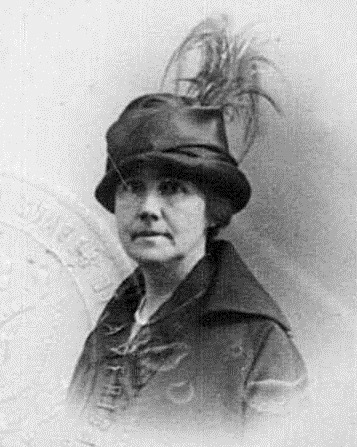
Isabelle Layton Wyatt was born in September 1869 in Caroline County, Virginia, to Richard W. Wyatt and Mary Eubank. In September 1891, Isabelle, who went by “Belle,” married Joseph Edward Willard, a Virginia politician, U.S. diplomat, and philanthropist. In July 1892, Belle gave birth to a daughter, the aforementioned Belle Wyatt Willard. In 1893, Joseph E. Willard built a home in the town of Fairfax and named it Layton Hall after his wife. 1913 was an auspicious year for Belle Willard. Her husband was appointed the U.S. ambassador to Spain, and her daughter married Kermit Roosevelt, a son of President Theodore Roosevelt.
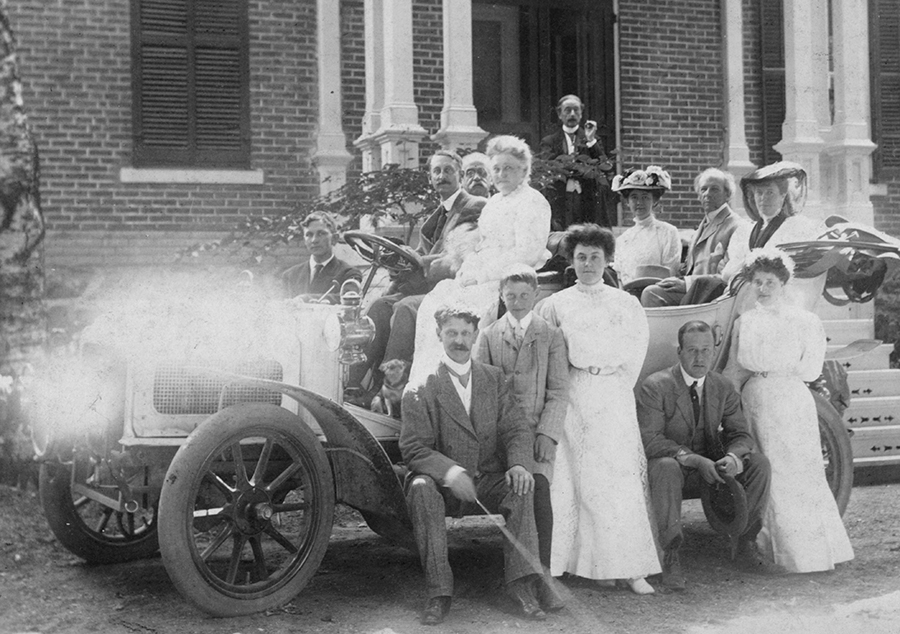
Belle Layton Wyatt Willard died in January 1954 and was buried next to her husband in Oak Hill Cemetery in Washington, D.C. Her home, Layton Hall, once stood on land that is now part of the parking lot of Courthouse Plaza Shopping Center. The dwelling was destroyed as part of a training exercise by the Fairfax City Fire Department in December 1963.
